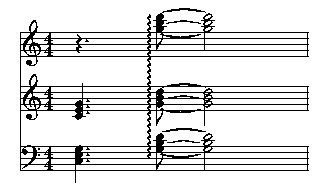Rolls can be specified with the "roll" statement, which has a format:
roll staff voice : timeval;
A simple example would be:
roll 2 1: 3;
Multiple rolls in a measure can be listed on a single statement if they are
associated with the same voice. For example:
1: ceg;dfa;egb;fac+; // rolls on 3 chords: on the first, // second, and third beats of the measure roll 1: 1;2;3; bar

A roll can extend over several chords on different voices, or even
different staffs. This is specified
by giving the top and bottom staffs and voices, with the keyword "to"
between them. For example:
1: 4.r;8g+b+d++ tie;2; 2-3: 4.ceg;8gbd+ tie;2; roll 1 1 to 3 1: 2.5; bar

If you wish the roll to be downward, the keyword "down" can be placed
after "roll." This will result in a downward arrow being drawn on the
bottom end of the roll.
score vscheme=2o music 1 1: c+e+g+;;;; 1 2: ceg;;;; // downward roll on staff 1 // on beats 2 and 4 roll down 1 1 to 1 2: 2; 4; bar
